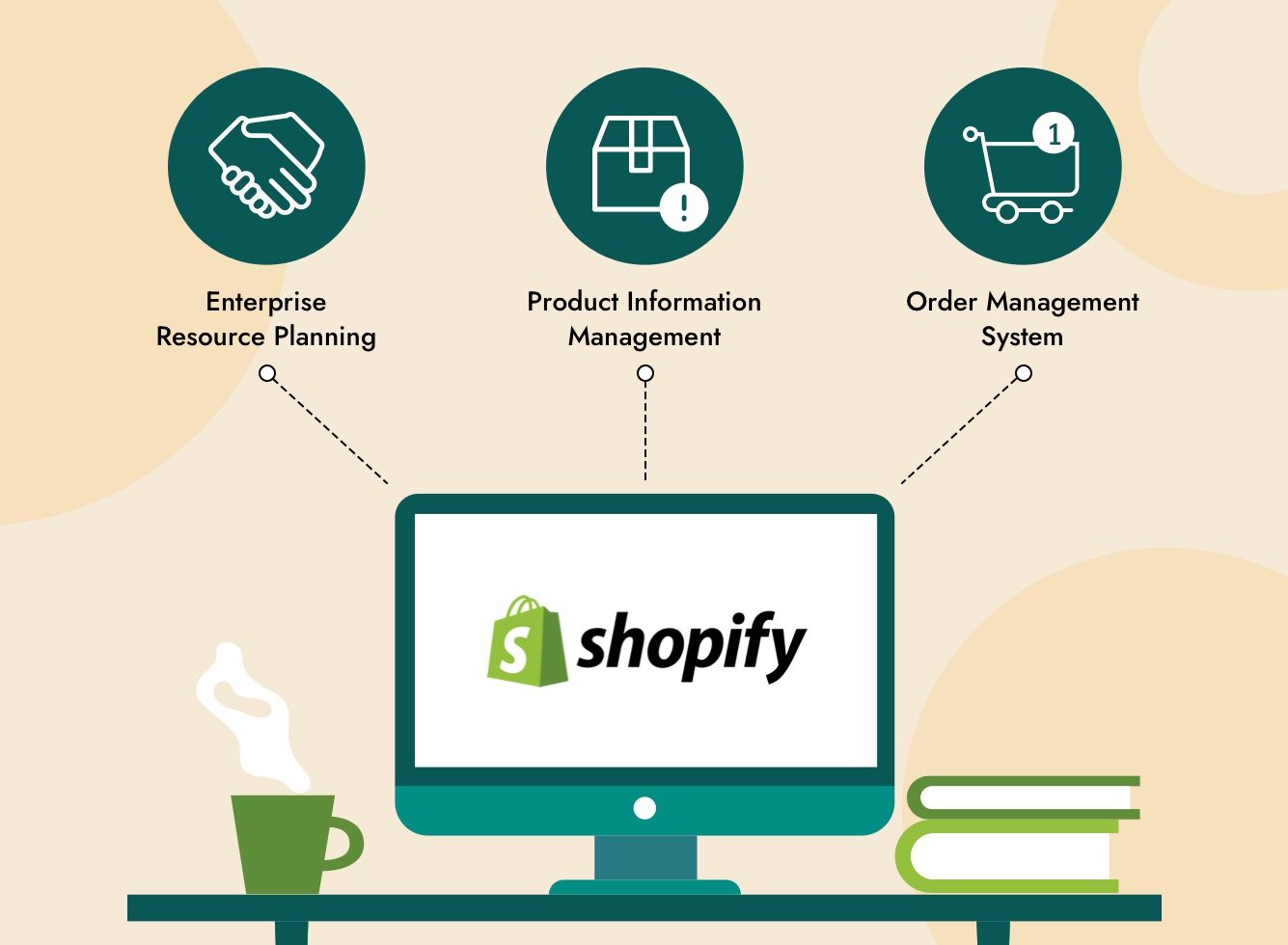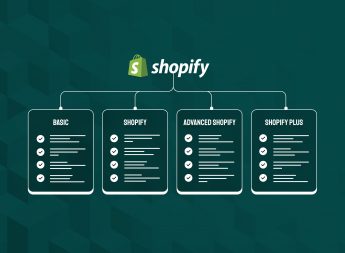ERP, PIM, OMS Integration with Shopify

Shopify is a powerful eCommerce solution that comes complete with features and functionality that enable you to start selling online right out of the box. But to get even more out of your online store, you can leverage Shopify integration services. Third-party solutions like ERP, PIM, and OMS will help you to organise products, implement store customisation, accept online payments, monitor and manage orders, and so much more.
The following article breaks down the core elements of Shopify ERP integration, Shopify PIM integration, and Shopify OMS integration.
ERP System Integration with Shopify
What is ERP?
An ERP (Enterprise Resource Planning) system is a software solution used by a company to manage core business processes including accounting, human resources, sales, supply chain, procurement, and manufacturing among others. It’s key to providing company-wide visibility through access to real-time data from anywhere at any time.
How does ERP Help Shopify Businesses?
Implementing an ERP system, helps your Shopify business alleviate the following problems that would otherwise hinder your performance:
- Using resources inefficiently
- Challenges in accessing and applying information from primary and complementary databases
- Entering data manually and managing databases using spreadsheets
- Monotonous, unnecessary processes that add little to no value to your business functions
- Slow responsiveness to changes
As a result, ERP implementation helps to boost your ROI and profitability by integrating, automating, streamlining, and tracking your end-to-end eCommerce functions and processes.
When to Use ERP with Shopify?
If you’re a larger eCommerce company that operates in different regions through multiple channels, an ERP solution will add great value to your Shopify store. It helps you to amalgamate all your key operational data, in particular, information that requires reconciliation with financials.
Benefits of ERP
Here are some of the main benefits a Shopify ERP system delivers.
- Providing access to company data is a centralised, secure location
- Assisting strategic decision-making through smarter business intelligence
- Tracking KPIs in real-time
- Integrating business departments by monitoring workflows, verifying data integrity, and pinpointing duplicated information
- Improving collaboration across departments
- Delivering financial visibility
- Keeping IT costs under control
- Streamlining the process of accurately tracking sales and inventory
- Boosting efficiency in the supply chain
- Facilitating better customer service
PIM System Integration with Shopify
What is PIM?
A PIM (Product Information Management) system manages your master catalogue of products by accessing product data from across the board and consolidating it in a centralised location. This enables your business to administer and update all your product information such as SKU data, item numbers, multimedia, catalogues, documentations, and so on from the PIM solution’s interface.
Why do You Need a PIM-Shopify Integration?
If you find yourself spending more money on a range of third-party plugins than you are on your marketing strategy or business process, a PIM-Shopify integration could be just what you need. Here are some key reasons why PIM will boost the performance of Shopify and your business as a whole.
- Increase the speed to selling on Shopify through fast product setup
- Boost productivity via PIM workflow
- Easily upload product images in bulk
- PIM ensures your products are market-ready
- Streamline multichannel selling on third-party marketplaces
- Implement an SEO to increase store visibility and ultimately revenue
When to Use PIM with Shopify?
You may ask yourself how a PIM system adds value to your eCommerce store if Shopify stores your product catalogue. You should utilise Shopify product information management in any of the following points apply to you:
- You have a substantial catalogue that contains data from various sources
- You’re selling through more than one channel and need visibility across the board
- You’re looking to sync products between more than one Shopify store
The Benefits of Using PIM with Shopify
Integrating PIM with Shopify delivers numerous benefits to your eCommerce operation. A few of these include:
- Product data governance – PIM helps merchants reduce errors with tags and set rules that improve the quality of product data
- Product data management for multiple stores – PIM enables merchants to manage data at different levels and determine the data points that are pushed to different stores.
- Enrichment automation and automation of other tasks – PIM automation allows for rules and logic to assign data to products, associate products to categories, assign assets, and so on.
- Efficient management in other areas – Shopify-PIM integration also helps to manage category merchandising, product collection association, logic for things like related products, the addition of site-wide breadcrumb links, and much more.
- Unifying product data for various channels and stores – PIM ensures different product data elements are unified at a global level
OMS System Integration with Shopify
What is OMS?
An OMS (Order Management System) tracks sales, orders, inventory, and fulfilment. This platform enables the requisite people, processes, and partnerships for products to reach the end customer. Modern order management needs a dynamic solution that interacts with most facets on your business operation such as:
- Products information
- Sales channels
- Inventory status and location
- Order picking, printing, processing, packing, and shipping
- Customers
- Customer service
- Suppliers for purchasing and receiving
What does OMS do?
Regardless of your business size or sector, an OMS has to fulfil certain functions. Here are some of the most important ones it should help your e-commerce business with.
- Tracking all orders and centralising sales, which boosts efficiency, productivity and eliminates errors.
- Monitoring and managing inventory to prevent overselling, overstocking, and inaccurate forecasting.
- Streamlining order fulfilment by improving logistics processes such as routing orders to the correct warehouse and auto printing shipping labels.
- Facilitating reverse logistics, which makes the process of managing refunds, replacements, and borders a lot more seamless.
Types of Order Management Systems
Different businesses have different OMS requirements depending on elements like size and the complexity of operations. Here are five of the most common OMS systems you can select.
- Manual order management – a very labour-intensive type of order management that may only work for the smallest companies.
- An eCommerce platform – eCommerce platforms can double-up as an OMS but are best if all orders come through your site and you only need simple order fulfilment, among other elements.
- Standalone order management software – a solution that becomes part of your retail tech stack and works with your eCommerce platform and accounting software among others.
- Enterprise retail platform software – a solution that unifies more business operations and department outside order management including inventory management, warehousing & logistics, customer relationship management (CRM), and HR & payroll.
- Digital operations platform for retail – a platform that encompasses all aspects of the order process. It centralises and unifies all company data and operations while providing flexibility and agility to business changes to facilitate growth.
The Benefits of OMS
A Shopify order management system delivers many benefits to your eCommerce operation, some of which are highlighted below.
- Automation – an OMS enables merchants to automate monotonous, time-consuming processes that take away from other business critical areas.
- Minimises human error – since an OMS automates most tasks, there’s a much lower chance of simple errors that can lead to major problems.
- Real-time reporting – an OMS helps to ensure you always have up to date information at hand, which improves accuracy and facilitates decision-making.
- Enhanced customer experiences – an OMS can improve customer service through more accurate shipping & delivery information, faster responses to order status queries, and so on.
Guide to Choose the OMS
You must take a range of factors into consideration when choosing an OMS. Use the steps below as a guideline for selecting the best OMS for your specific needs.
- Define your goals and priorities – Determine which features and functionality are an absolute necessity without forgetting to factor in scalability for the future.
- Draft a request for proposal (RFP) – The RFP will align you and order management solution vendors. Include all essential information such as number of SKUs, order volumes, your existing business tools, and so on to ensure you receive a tailored proposal.
- Evaluate your options – Have a checklist of the requirements you need for your OMS ready when you start contacting potential vendors. Request demos or product trials for each one before making a final decision.
The Power Of ERP, PIM & OMS
Integrate an EPR, PIM, and OMS solution with an eCommerce platform like Shopify to streamline your operational processes, increase productivity and drive sales growth. If you’re looking for a Shopify development agency to integrate ERP, PIM, and OMS, look no further than Vsourz. We have extensive experience integrating these third-party solutions with Shopify so don’t hesitate to get in touch to learn more or discuss your project.






